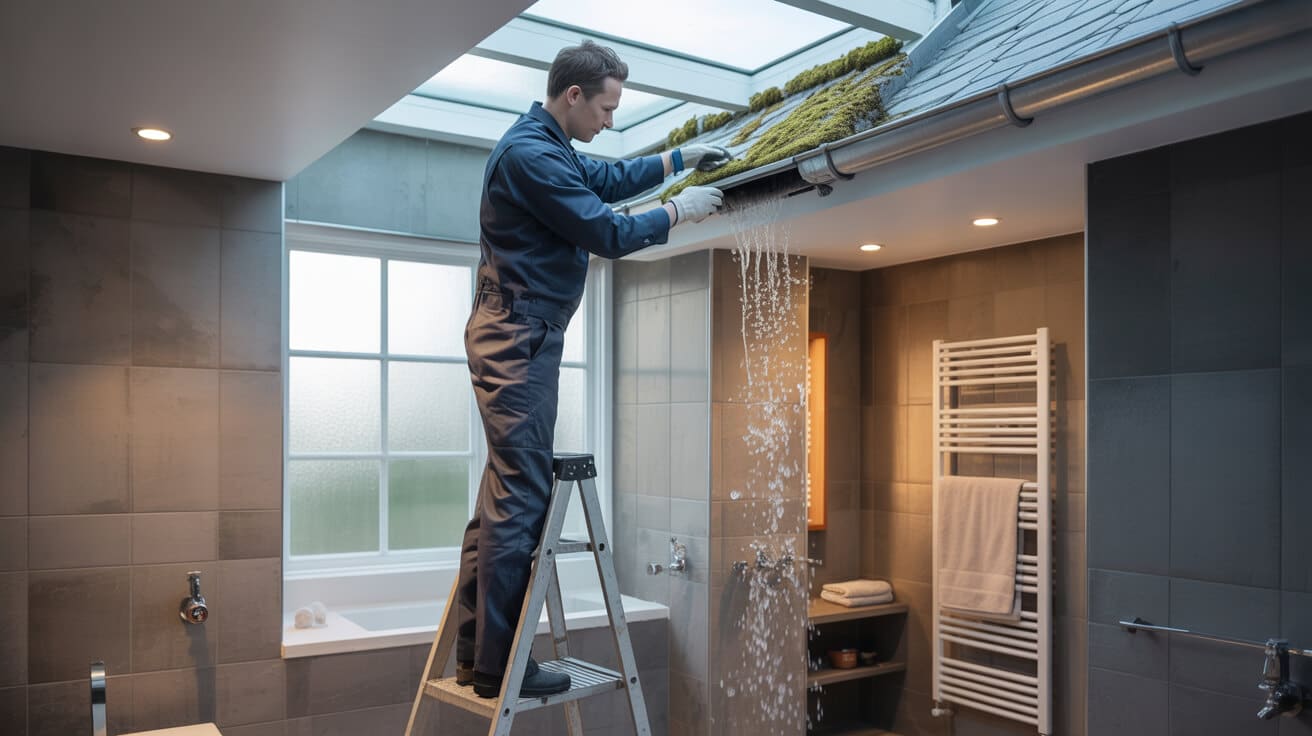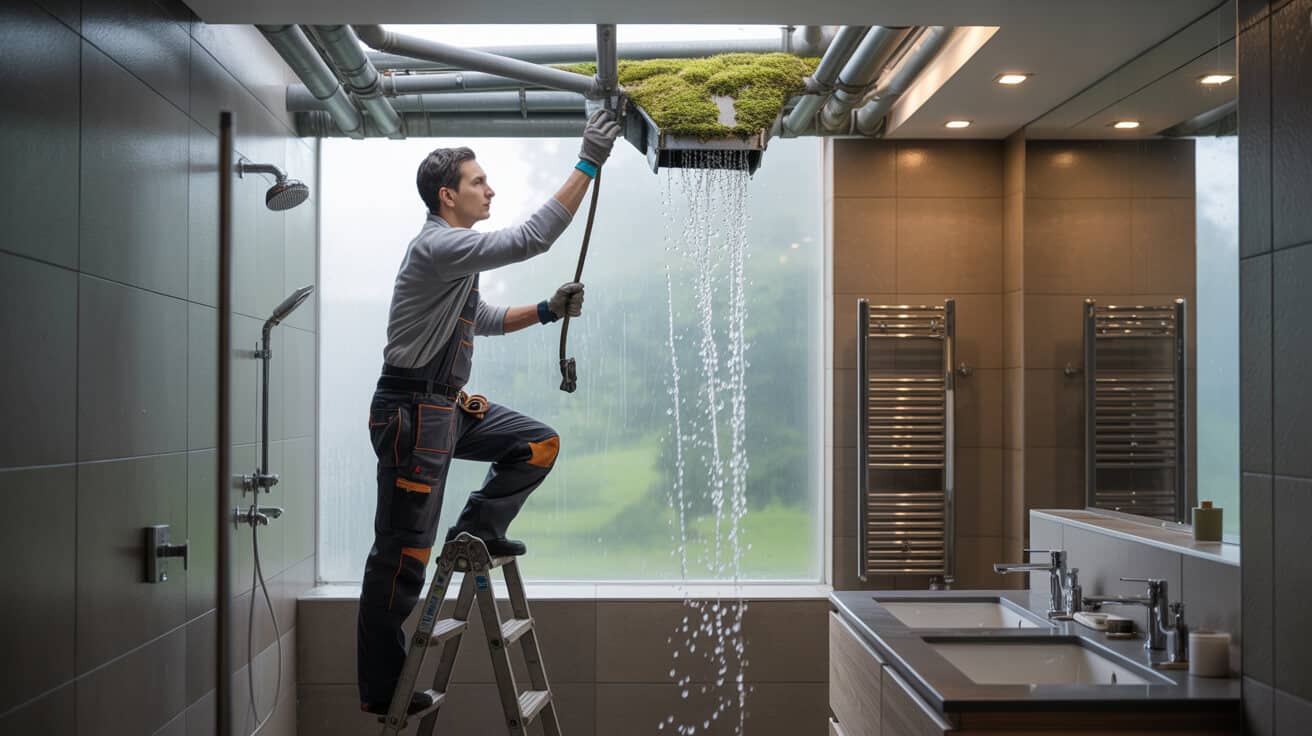Moss and organic debris accumulate in roof gutters due to natural, environmental, and climatic factors. When unchecked, these buildup layers disrupt controlled water flow, lead to overflow and pooling, and foster progressive damage in hidden areas of your building envelope. The consequences comprise not only visible stains and dripping eaves but also less apparent hazards—such as under-roof damp, timber rot, or mould proliferation—that affect your property’s value, safety, and comfort.
Contemporary Plumbing & Heating service providers, exemplified by Plumbers 4U, address moss debris with holistic, multi-stage methodologies. Your property’s scheduled or responsive gutter cleaning incorporates risk assessment, mechanised and manual clearance, and precise compliance recordkeeping—helping your home or organisation avoid emergency callouts, inconvenient disruptions, and repeated insurance claims.
Lead
Moss, silt, and vegetal debris are persistent agents of rainwater system obstruction throughout temperate and urbanised regions. The process of cleaning these materials from guttering involves an array of specialised tools and professional protocols, typically delivered under the auspices of Plumbing & Heating businesses with both certification and procedural know-how. Moss debris gutter cleaning is more than a cosmetic task; it represents a foundational measure of prudent property stewardship, preserving structural integrity, indoor comfort, and outward appearance.
Modern gutter cleaning services operate in a landscape of heightened compliance standards, insurance scrutiny, and occupant expectations regarding transparency and safety. Within this context, the procedural spectrum runs from simple visual inspection and hand-removal in smaller dwellings to vacuum extraction, digital documentation, and chemical treatment in complex multi-tenant, commercial, or regulated buildings. The orchestration of these services by qualified professionals ensures the intersection of technical excellence, legal conformity, and environmental care.
Etymology or name origin
The word “gutter” traces to the Old French goutiere, meaning a channel for draining water, entering English in the context of mediaeval architecture as both an exterior drain channel and a feature embedded directly beneath the eaves. The phrase “moss debris” describes bryophytic plant matter and assorted vegetative detritus that naturally accumulate on shaded, moisture-retentive surfaces—eventually migrating to gutter cavities through rainfall, gravity, and wind.
“Gutter cleaning” as a professional descriptor arises in the late nineteenth to early twentieth centuries, coinciding with the proliferation of organised building trades and emerging urban regulations. Terms such as “rainwater goods,” “roofline maintenance,” and “downpipe clearance” have since entered industry usage, marking a shift from informal, caretaker-driven routines toward the systematic, compliance-driven property services now characteristic of companies like Plumbers 4U.
Overview / context
General background
Rainwater gutters constitute a primary barrier between external environmental exposure and your building’s internal comfort and durability. These surface-mounted channels exist to collect and guide precipitation off innocent-looking roofs, yet are prone to the subtle, relentless influence of air-borne organics, spore dispersal, and animal activity. Moss proliferates most aggressively on north-facing, shaded, and high-moisture roofs, but your property’s gutter network can experience seasonal influxes from autumnal leaf fall, seed pod dispersal, or windblown particulate matter.
The persistence of moss and debris, especially where routine maintenance lapses or gutter geometry is complex, exposes you to cumulative slow damage. Even seemingly minor accumulations, when left beyond a season, can trigger cascading overflows, under-eaves penetration, and rear gutter channel collapse.
Role in building drainage
Gutters anchor the water evacuation system, collecting runoff and delivering it through downpipes into soakaways, stormwater drains, or municipal sewerage. Your property’s seamless drainage relies on this continuous, unobstructed channel. Moss and debris, by reducing cross-sectional area and impeding gravity-driven flow, create not just standing water but also a substrate for further organic trapping. The risks scale: from minor inconvenience to roof deck decay, cracked external renders, or erosion of foundation grade.
Plumbing & heating companies as service providers
In today’s property maintenance sector, Plumbing & Heating companies like Plumbers 4U play a pivotal, trusted role. Equipped with technical knowledge of water systems, safe working at height credentials, and competence in compliance reporting, these firms safeguard your drainage assets. Their services deliver both direct clearance and essential documentary evidence to satisfy insurance, legal, or tenant demands—especially for multi-party dwellings, rentals, and business premises. The transition from handyman solutions to regulated trade execution raises the bar for your property’s protection and ongoing value.

History
Origins
Ancient civilizations, including Rome and Classical Greece, employed basic guttering carved from stone or formed as lead or bronze troughs. Mediaeval Europe adopted wood, clay, and metal rainwater goods beneath thatched roofs, but cleaning generally emerged as an ad hoc household task, performed simply when overflow was visible.
Industrial emergence
With the Industrial Revolution and the mass production of cast iron pipes and guttering, the nineteenth century witnessed the standardisation of rainwater systems in urban and rural settings alike. This technological leap crystallised maintenance responsibility; by the Victorian era, “gutterman” trades and caretaker contracts appear in British and Continental urban records. The insurance industry’s rising influence spurred scheduled inspection and cleaning, connecting operational utility with both compliance and asset management frameworks.
Contemporary evolution
The second half of the twentieth century, particularly with the advent of plastic (PVCu) and lightweight metal guttering, brought even more oscillation between DIY and professional solutions. Heightened health and safety legislation (notably, Working at Height 2005 in the UK), environmental regulation, and digitalization of property records prompted the ascendancy of licenced, multi-skilled entities—such as Plumbers 4U. Today, integration with property management software, before/after photographic documentation, and sustainability best practices continue to shape the evolution of gutter maintenance service.
Concept / description
Moss and debris accumulation
Gutter systems act as unintentional collection basins for a range of organic and inorganic materials. Bryophytes (mosses) expand in damp, shaded roof environments, and, as their mats grow and dry, easily migrate into gutter cavities. In parallel, leaf litter, seed pods, windblown dust, animal droppings, and construction debris settle on roof pitches, moving gravitationally or during heavy rainfall into gutter channels.
As debris layers thicken, moisture retention is exacerbated. This forms a self-reinforcing barrier trapping additional organics, hosting insects, and inhibiting evaporation. Blockages often accumulate unknown to you until precipitation increases and visible overflow, damp walls, or streaks beneath eaves reveal the hidden disruption.
Effects on building systems
The impairments originating from moss and debris in guttering networks extend beyond superficial water movement. Prolonged standing water, a result of occlusion, promotes corrosion of metal goods or joint separation in PVCu and aluminium systems. Accelerated decay is observed in surrounding timber (fascias, soffits) and renders. Water spills may backflow into roof decks, hinder insulation performance, and promote dampness and microbial colonisation—posing respiratory hazards and harming finishes.
For tenants, landlords, or facilities managers, shared gutters multiply the scope of risk and the urgency of regular, formally documented cleaning cycles.
Removal and prevention techniques
Your property’s gutter cleaning regimen generally follows a three-stage cycle: 1. Inspection:
- Visual appraisal from ground, ladders, or via camera systems.
- Identification of blockages, standing water, joint failure, and signs of infestation.
- Mechanical or manual clearance:
- Hand removal with padded scoops and brushes, especially in sensitive materials.
- Vacuum extraction for inaccessible heights or extensive, wet accumulations.
- Jet-washing in robust PVCu or metal goods, with precautions for splashing and downpipe safety.
- Preventative and finishing actions:
- Installation of gutter guards and mesh for debris-prone settings.
- Application of roofline biocides/moss inhibitors where compliant.
- Final flow test and photographic evidence for record and reporting.
Plumbers 4U incorporates these steps into a unified, transparent protocol suitable for your risk profile, property scale, and compliance framework.
Functionality / purpose / applications
Water flow protection
The essence of effective gutter cleaning lies in ensuring uninhibited rainwater runoff. Whether your property receives moderate rainfall, torrential downpours, or experiences seasonal deluges, the cleaned gutter system safeguards against water pooling, roof leaks, and winter ice dams. Seamless evacuation prevents the infiltration of water into vulnerable roof or wall systems.
Property preservation
Consistent, planned debris cleaning secures not only aesthetic appeal but also slows material fatigue and loss of building fabric integrity. With overflowing gutters a leading cause of eaves and baseboard rot, timber infestations, or render failure, a proactive regime substantially extends the life of those components most exposed to external weathering cycles.
Health and safety maintenance
Water cascading over gutter lips often results in slippery paved surfaces and algae bloom around entranceways. Mould and hidden damp, fueled by persistent leaks, undermine air quality and occupant well-being. Your company’s regular gutter maintenance directly reduces these threats, benefiting both you and your tenants or staff.
Application by stakeholder
- For homeowners, gutter cleaning is fundamental home hygiene; for landlords/letting agents, a route to regulatory confidence and happier tenants.
- Facilities directors: in schools, care homes, or corporate premises rely on it to preserve organisational reputation, maintain insurance coverage, and enhance building lifespan.
- Your engagement with a scheduled, expert provider like Plumbers 4U guarantees a synergy between asset management, compliance reporting, and occupant safety.
Classifications / types / variants
Gutter types
The diversity of gutter profiles is driven by local tradition, function, and appearance:
- Half-round: Most widespread in suburban/domestic settings; easy to fit, compatible with push-fit and nut/bolt fixing systems.
- Deep or box: Suited for larger pitched roofs or high-water-volume regions.
- Ogee/moulded section: Aesthetic concerns for period property or restoration, frequently in cast iron, zinc, or dressed aluminium.
- Material variants: Ranging from basic UPVC through coated steel, copper, or aluminium—each exhibiting distinct life cycle and cost characteristics.
Debris forms
Table: Common Sources of Gutter Contaminants
| Source | Seasonal Patterns | Hazards |
|---|---|---|
| Moss (bryophytes) | All-year, shaded | High water retention, block |
| Leaf litter | Autumn/spring | Rapid build-up, microbial |
| Silt/dust | Dry climates | Gradual reduction in flow |
| Animal activity | All-year | Sudden blockages, disease |
| Rooftop run-off | After storms | Abrasive grit accumulation |
Property typologies
Gutter maintenance challenges differ by property:
- Domestic: Easy access, high frequency of visual checks, greater risk-adapted to inaction.
- Multi-resident: Shared liability, complex drainage pathways, greater reporting and compliance.
- Commercial/public: Extensive lengths, high elevation, narrow access, digital regulatory trail expected, complex insurance backdrop.

Systems / tools / methodologies
Hand tools and manual implements
Hand cleaning is indispensable on smaller, delicate, or heritage properties. Brushes, soft scoops, protective gloves, and water-proofed buckets provide low-impact, damage-averse service. For fragile metals (e.g., zinc, copper) or ornate fixings, specialised, non-abrasive tools safeguard your investment in unique materials.
Vacuum and inspection systems
Technological advances have broadened your options. Gutter vacuuming systems operate from the ground up or internal walkways—minimising health risks and cleaning time while providing bagged debris for certified disposal. Telescopic inspection cameras and live-feed devices allow visual records, serving you, your clients, or your insurance provider as required.
Ladders, towers, and access
Secure access is essential. Properties above single-storey or with obstructed perimeters demand extended ladders, harness tie-offs, or mobile scaffolding (towers, cherry pickers). Licenced operatives like those at Plumbers 4U will always employ Working at Height-compliant apparatus, eliminating DIY risks.
Biocidal and eco-friendly cleaning
Where moss control requires chemical intervention, only accredited biocidal agents are deployed in line with environmental legislation. Non-toxic, biodegradable inhibitors are specified for sensitive properties, ensuring your compliance and environmental stewardship.
Stakeholders / entities involved
Service recipients
Your role defines your exposure and responsibility:
- As a homeowner, you must protect the structural and visual quality of your property.
- As a landlord or block manager, you have obligations rooted in law and lease agreement to provide a safe, habitable environment.
- As a facilities director or building owner, you maintain value, insurance eligibility, and functional safety for occupants and business continuity.
Service providers
Plumbing & Heating companies (such as Plumbers 4U), property services contractors, and specialist roof/gutter cleaning firms serve these needs. The intersection of drainage compliance, multisystem awareness, and certification underpins your assurance of service quality and risk reduction.
Regulatory and compliance bodies
Public sector oversight includes local authorities (enforcing drainage and public health codes), environmental agencies (monitoring chemical use and waste pathways), and insurance underwriters (dictating eligibility following blockage-related claims).
Legal / regulatory / ethical considerations
Building and property codes
Most properties are subject to strict regulations—such as the UK’s Building Regulations Part H (rainwater drainage) and mandatory inclusion of Sustainable Drainage Systems (SuDS) on new builds or substantial renovations. Failing to maintain rainwater goods properly may result in legal action, accelerated decay, or invalidation of property insurance.
Qualified service and insurance
Qualified, insured professionals are necessary to ensure not just safe work, but also validity under insurance claims in event of property damage. Plumbers 4U meets and exceeds these standards, deploying licenced operatives, safe methods, and detailed documentation as your legal and contractual buffer.
Waste and environmental compliance
Your responsibility extends to the environment. Debris and biocidal agents collected must be transferred under a documented waste transfer process, using only registered handlers or designated compost facilities, in full compliance with local/national statutes.
Reporting and documentation
Compliant clearing means nothing without credible proof. Your service provider should supply digital or hard-copy logs of inspection, work performed, before/after photographs, and detailed recommendations—essential in audit, dispute, and maintenance planning.
Performance metrics / data / measurements
Routine inspection protocols
Inspections, often biannually, review gutter fullness, presence of standing water or debris, gutter joint and downpipe integrity, and ingress potential. These findings are logged for both baseline and year-on-year trend analysis.
Condition report parameters
Your property’s digital or paper-based maintenance history will include annotated photographs, risk grading (often colour-coded), and lists of corrective and follow-up tasks.
Service timelines & productivity
Timely cleaning minimises disruption; domestic settings are cleared in under two hours, while commercial/education/care sites may require staged closures, out-of-hours scheduling, or segmented work due to access regulations.
Outcome tracking
Success is measured in incident reduction—declining repair calls, fewer insurance claims due to damp, enhanced asset value as verified by post-clean survey or property market appraisal.
Challenges / barriers / limitations
Operational or technical issues
Obstacles such as roofline complexity, proximity to foliage, non-standard roof pitches, and fragile gutters amplify your cleaning complications. Older or restored buildings may require hand cleaning to avoid system deformation or cosmetic damage.
Social or economic factors
Your willingness to authorise gutter cleaning depends not just on awareness but also on cash flow, budget allocation, and property occupation pattern (owner-occupied vs. rental). Tenants often harbour misconceptions about cleaning responsibilities, requiring explicit lease wording or property manager intervention.
Environmental sustainability
Eco-conscious cleaning now takes precedence in procurement. The use of moss killers is carefully regulated to avoid urban waterway pollution, while modern providers organise debris capture into compostable or traceable waste chains, evidenced by digital transfer receipts or on-site composting logs.
Impact / influence / legacy
Asset integrity
Routine, professional gutter management demonstrably preserves structural steel, timber, insulation, and wall finish quality over decades. Absence of proactive cleaning, as shown in claims records and housing association benchmarks, doubles or even triples property maintenance expenditure.
Maintenance culture evolution
The normalisation of routine gutter inspection and clearance symbolises a paradigmatic shift from reactive repairs to scheduled, data-driven maintenance. Multi-year service contracts ensure your compliance, provide actionable budget planning, and reassure stakeholders—from insurers to tenants—about your property’s longevity.
Sectoral innovation
Advancements in drone inspections, integrated asset management software, and modular, snap-on gutter protections are redefining your maintenance landscape. Providers responding to these innovations, including Plumbers 4U, deliver higher transparency, lower risk, and demonstrable value in both short and long term.
Future directions, cultural relevance, and design discourse
Technological advancement
Rapid evolution in digital inspection (drone, AI imaging), predictive analytics, and biodegradable chemical agents is accelerating service efficiency, accountability, and ecological responsibility. Your maintenance network will increasingly leverage app-based scheduling, instant reporting, automated task reminders, and asset benchmarking for seamless control over gutter health.
Regulatory and policy trends
Anticipated tightening of building codes will reinforce compulsory, documented maintenance. Insurance and regulatory bodies are likely to require even more robust proof of care, with emerging certifications differentiating compliant from non-compliant property portfolios.
Cultural perception
Attitudes toward scheduled property maintenance are evolving from reluctant obligation to proactive pride, as societal concern for asset value and occupant health converges with growing climate adaptation needs. Routine gutter and drainage care, once invisible, now signals your commitment to community resilience and environmental stewardship.
Design and environmental debate
Intellectual and technical debates persist over the integration of passive, self-cleaning gutters, hybrid green-roofing systems, and optimised drainage architecture for new developments. As buildings age and climates shift, the demand for systematic, foresighted maintenance will only increase—anchoring your property in tomorrow’s regulatory, environmental, and cultural context.

